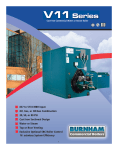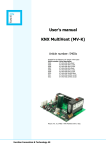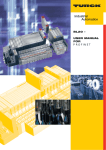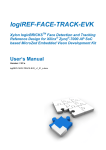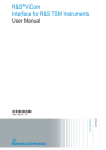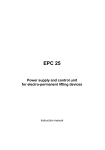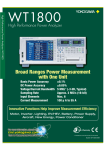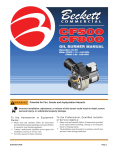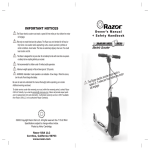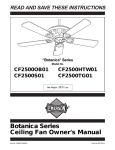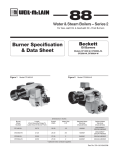Download 3 axis controller user manual
Transcript
3 axis controller User manual © 2002 Twintec Twintec controller user manual 3 axis controller user manual © 2002 Twintec All rights reserved. No parts of this work can be reproduced in any form without a written permission of the author. The products to who references are made in this manual can be trademark of the respective proprietary. The author assume no responsability for errors or omissions, or for damage caused by the usage of the informations contained in this document and by the usage of the products to who it refer. In no case the author can be responsible of damage caused directly or indirectly by this document. Printed: novembre 2002 at Gravina di Catania Italy Published by: Twintec Address: Via Monti Arsi, 13 95030 Gravina di Catania IT Tel. 39 95 7253415 Author: Michele Ribaudo Web site: http://www.twintec.it e-mail: [email protected] I 3 axis controller user manual Contents Introduction 0 2 I Introduction 1 Controller................................................................................................................................... manual 2 3 II Hardware 1 General description ................................................................................................................................... 3 2 Connections ................................................................................................................................... description 5 3 Electrical characteristics ................................................................................................................................... 7 4 Status indicators ................................................................................................................................... 7 5 Accessory................................................................................................................................... 7 Controller ......................................................................................................................................................... connector 7 8 III Software 1 Command................................................................................................................................... syntax 8 2 List of commands ................................................................................................................................... 8 Move ......................................................................................................................................................... 8 Move contour ......................................................................................................................................................... 8 Set the contour ......................................................................................................................................................... angle 9 Set the speed ......................................................................................................................................................... 9 Set the acceleration ......................................................................................................................................................... 9 Activate output ......................................................................................................................................................... 10 Wait an input ......................................................................................................................................................... 10 Wait a time ......................................................................................................................................................... 10 Execute home ......................................................................................................................................................... 10 Set the position ......................................................................................................................................................... 11 Configure......................................................................................................................................................... 11 12 IV Operation principles 1 General Principles ................................................................................................................................... 12 2 Communication ................................................................................................................................... 13 3 Speed and ................................................................................................................................... acceleration 13 4 Vector's execution ................................................................................................................................... 15 Index 16 © 2002 Twintec Introduction 1 Introduction 1.1 Controller manual This manual, destinated to the controller users is divided in 4 sections to make more easy the arguments reading. We choose to not limit the manual to the simple thecnical description of the controller but to explain any argument, providing, where possible, examples and pictures than can give to the reader further informations for a correct use of the controller and a better understanding of it functionality. Further informations can be found on our web site: http://www.twintec.it Twintec di Ribaudo Michele Via Monti Arsi, 13 95030 Gravina di Catania ITALY Tel. 39 95 7253415 © 2002 Twintec 2 3 3 axis controller user manual 2 Hardware 2.1 General description 3 axis controller · · · · · · · · · · · · · · · · Eurocard board 100X160 mm. connector DIN 96 poles. LED indicators for power, execution and error. Power supply 5V 200 mA. 3 AXIS interpolated. 2 serial port: Rs232 19200-38400 BPS. e RS 485 19200 a 38400. Communication protocol: RS232 Hardware Handshake via CTS-RTS.. 8 user input CMOS 5V. 8 user output OPEN COLLECTOR max 100 mA. Inputs for HOME and LIMIT for all axis. STOP input. STOP with deceleration and acceleration at restart. CONTOURING with adjustable angle. Battery for data retention (6 month). Configuration buffer for startup. Input and output commands. Timing commands. Drawing of the controller. © 2002 Twintec Hardware Led indicators descripition: · PWR=POWER LED · ERR=ERROR AND STOP LED · STAT=STATUS LED © 2002 Twintec 4 5 3 axis controller user manual 2.2 Connections description In the following table the name of the signals. VCC 5V supply. GND Ground. PULSE0 PULSE1 PULSE2 DIR0 DIR1 DIR2 Step output X Step output Y Step output Z Direction output X Direction output Y Direction output Z UI0.. UI7 UO0..UO7 UO Com. User inputs. User outputs. Common snubber for outputs HOME0 HOME1 HOME2 LIM0 LIM1 LIM2 RXD TXD CTS RTS ANA1 ANA2 Home input X. Home inputY. Home input Z. Limit Input X. Limit input Y. Limit input Z. Data input rs232 Data output rs232 Clear to send rs232 Request to send 232 Analogic input 0-5V Analogic input 0-5V PULSE3 DIR3 Step output (optional). Direction output (optional). The following table show the drawing of the connector front view and the coresponding pin and signal. © 2002 Twintec Hardware a32 a31 a30 a29 a28 a27 a26 a25 a24 a23 a22 a21 a20 a19 a18 a17 a16 a15 a14 a13 a12 a11 a10 a9 a8 a7 a6 a5 a4 a3 a2 a1 b32 b31 GND b30 b29 b28 b27 LIM0 b26 STOP b25 LIM2 b24 b23 CTS b22 TXD b21 RXD b20 UI7 b19 UI2 b18 b17 b16 Dir 0 b15 Pulse0 b14 b13 GND b12 GND b11 b10 b9 b8 b7 UO2 b6 UO5 b5 UO Com. b4 GND b3 VCC b2 VCC b1 Here the serial connector. Connettore DB9 RS 232 ANA 1 LIM 1 HOME1 RTS UI1 UI5 GND GND Dir 1 Pulse1 GND UO1 UO4 UO7 GND VCC VCC ANA2 HOME0 HOME2 UI0 UI6 UI3 UI4 GND Dir 2 Pulse2 GND Pulse3 Dir3 UO0 UO3 UO6 GND VCC VCC Data receive (PC) Data transmit (PC) Shortened (DTR DSR) Ground Clear to send (PC) Request to send (PC) Related signals 1 GROUND 2 BUS A 3 BUS B © 2002 Twintec GND Related signals 2 RXD 3 TXD 4-----6 5 GND 7 CTS 8 RTS and the RS 485 connector RS 485 connector GND c32 c31 c30 c29 c28 c27 c26 c25 c24 c23 c22 c21 c20 c19 c18 c17 c16 c15 c14 c13 c12 c11 c10 c9 c8 c7 c6 c5 c4 c3 c2 c1 6 7 3 axis controller user manual 2.3 Electrical characteristics Power supply: 5V 200 mA max. Input home and limits: Normaly closed CMOS 5 V with pull-up da 10 KOhm. User input: pull-up 10KOhm. User output: Open collector max 100 mA. Step and dir output: Open collector without pull-up. Ouput IC: ULN2803; Input IC: 74HC244; 2.4 Status indicators The LED indicators are three: 1. 2. 3. GREEN LED: indicate the power is on. RED LED: Have three states: · OFF: nessun errore. · FLASHING: The STOP is Pressed. · ON: A limit have benn reached. YELLOW LED: have two states: · 1 sec. Flashing: The controller is in the stand-by state. · 1/2 sec. flashing: The controller is executing commands. 2.5 Accessory 2.5.1 Controller connector This board allow the connection of the controller with detachable connectors. It comprise a 5V stabilized power so the input can be 9~15 V cc.. On the back there is a LED that indicate the power presence and is possible to add a DB9 connector whenever the one on the controller will result in an unfavorable position. Power supply 9~15 V CC. 200 mA. © 2002 Twintec Hardware Nota: Not all the signals are disponible on that connector Signals present: UO common UO 0..3 UI 0..3 PULSE 0,1,2 DIR 0,1,2 LIM 0,1,2 STOP HOME 0,1,2 GND VCC ANA 1,2 3 Software 3.1 Command syntax All commands are of two characters and a list of parameters delimited by a comma, the command terminator is the semi-colon ";". MC100,100,100; Spaced are discarded by the controller. MC 100, 100, 100; The interpreter is case insensitive; mc 100,100,100; Follow the description of the commands, the syntax, limits and error condition. 3.2 List of commands 3.2.1 Move Syntax: MV X,Y,Z; Purpose: Move the axis at the specified position with acceleration and deceleration. Parameters: X,Y and Z. Example: MV 100, 100, 400; Limits: 8388608÷ -8388608 Errors: Missing parrameter, parameter out of limit. Note: The position are in step and are absolute. 3.2.2 Move contour Syntax: MC X,Y,Z; Purpose: Move the axis at the specified position inside a path. If the angle between the vector and the previous one is greater than the angle of contour the controller will decelerate if in move and then accelerate to begin this position motion © 2002 Twintec 8 9 3 axis controller user manual (see the paragraph for the vector execution). Parameters: X,Y e Z. Example: MC 100, 100, 400; Limits: 8388608÷ -8388608 Errors: Missing parrameter, parameter out of limit. Note: The position are in step and are absolute. 3.2.3 Set the contour angle Syntax: SI A; Purpose: Set the contour angle (see the paragraph for the vector execution). Parameters: A. Contour angle in degree; Example: SI 25; Limits: 0-360; Errors: Missing parrameter, parameter out of limit. 3.2.4 Set the speed Syntax: SV V; Purpose: Set the speed for the next vectors (see paragraph Speed and acceleration). Parameters: V. Speed in cm/s. Example: SV 2.5; Limits: 1.2-20; Errors: Missing parrameter, parameter out of limit. 3.2.5 Set the acceleration Syntax: SA A; Purpose: Set the acceleration in cm/s² (see paragraph Speed and acceleration). Parameters: A. acceleration in cm/s². Example: SA 5.5; Limits: 1.2-40; Errors: Missing parrameter, parameter out of limit. © 2002 Twintec Software 3.2.6 Activate output Syntax: EO bit,value; Purpose: Set the user output at the specified value. Parameters: bit: number 0..7, value 0-1. Example: EO 7,1; Limits: 0..7, 0-1; Errors: Missing parrameter, parameter out of limit. 3.2.7 Wait an input Syntax: WI bit,valore; Purpose: Wait a specified value on a user input bit. Parameters: bit: number 0..7, value 0-1. Example: WI 7,1; Limits: 0..7, 0-1; Errors: Missing parrameter, parameter out of limit. 3.2.8 Wait a time Syntax: EW tempo; Purpose: Wait for the specified time in ms. Parameters: time in ms. Example: EW 1000; wait a second Limits: 10-65536; Errors: Missing parrameter, parameter out of limit. 3.2.9 Execute home Syntax: EH x,y,z; Purpose: Bring the axis at the home position seeking the specified switch. At the end of the command the internal position is 0,0,0. Parameters: x,y,z. 0 mean no seek 1 mean seek the switch. Example: EH 1,1,0; Seek the home switch for the x and y axis. Limits: 0-1; © 2002 Twintec 10 11 3 axis controller user manual Errors: Missing parrameter, parameter out of limit. 3.2.10 Set the position Syntax: SP x,y,z; Purpose: Set the logical position without making any move. Parameters: x,y,z. Example: SP 1000,1000,0; Limits: Errors: Missing parrameter, parameter out of limit, command received in excecution phase. Note: This command have to be executed carefully, the command will be refused if the controller is excecuting vectors. 3.2.11 Configure Syntax: CF tipo, p1[, p2][, p2]; These commands are for configuration that are retained even when the controller power is not present. Configure HOME: Syntax: CF 1,x,y,z; Purpose: Set how the controller search the Home switch at the reset. Parameters: x,y,z. Default value: 0,0,0; Example: CF1,0,0; Limits: 0-1; Note: This command have no immediate effect, but it configure the controller to seek or not the home switch at the reset. If we send the command CF 1,1,1,0; at the next reset the controller will seek the switch that are set to one. Configure Axis resolution: Syntax: CF 2,x,y,z; Purpose: Set the axis resolution for the three axis in step/mm. Parameters: x,y,z. Default value: 40,40,40; Example: CF2,40,40,80; © 2002 Twintec Software Limits: 1-400; Note: this command have effect on the speed calculation. Configure Home Speed: Syntax: CF 3,f; Purpose: Set the home frequency. Parameters: f: frequency. Valore predefinito: 1000; Example: CF2500; Limits: 100-10000; 4 Operation principles This chapter describe the operation principle of a positioning system. 4.1 General Principles Block diagram of a positioning system: © 2002 Twintec 12 13 3 axis controller user manual The controller is the headt of a positioning system. It perform the following tasks: · Generate the direction signals and step frequencies to the drivers to move the motors at the desired position. · Activate the outputs. · Wait a status at an input. · Perform the timing between two command. · Transmit informations about the position and the status. · Acquire the Stop status. · Acquire the Limits status. · Seek the Home switch to put the axis in this position. The actions above mentioned can be performed by comunicating, trhough the serial PC line, with defined commands than will be executed by the controller in the sequence that are been transmitted. In the controller there is a receive buffer that allow the same to execute work of hours without interruptions. The communication handshake is managed by the CTS and RTS control signals. 4.2 Communication The communication with the controller is established with RS232: the line parameters are: Bit:8 Stop bit: 1 Parity: None Baud rate: 19200 bps. The cable to use is a simple direct MF DB9. The flow control signals are RTS and CTS. Note: in absence of those signals an overwriting of the buffer can occur with severe consequence for the correct excecution. The RS 485 is optional and is reserved for future or custom usages. 4.3 Speed and acceleration The speed, in a system composed by three axis is done with the following formula: here V is the speed and vx,vy, vx are the component speeds.The controller calculate the component speeds for any axis to make the final desired speed that can be set with the SVv; command where v is the speed in cm/s The acceleration of a system is the variation of the velocity with the time, this parameter is set in cm/s² in the controller. The controller have two command for the setting of these parameters, read the © 2002 Twintec Operation principles paragraphs set the speed e set the acceleration for a detailed esplanation of these commands. When the controller have to move at a defined position it start to send pulse with an increasing frequency until it reach the final speed and continue with this speed until it reach the position calculated for the deceleration. The following diagram show how the curve of the velocity for a single vector assume a trapeziodal form. The vertical axis represent the speed and the orizontal the time. If the length of the vector is too small to reach the final velocity the form of the curve is a triangle. 2 1,8 1,6 1,4 1,2 1 0,8 0,6 0,4 0,2 0 0 0,1 0,2 0,3 0,4 The correct setting of these two parameters (speed and acceleration) allow to reache optimal performances relating the speed and the positioning accuracy. It is necessary to consider the kind of work to execute before set these two parameters. The step loss can be a consequence of the incorrect setting of a speed or an acceleration. It is a good practice to refer with the caracteristics of the motor to find the correct values. © 2002 Twintec 14 15 3 axis controller user manual 4.4 Vector's execution To explain how the controller perform the axis positioning it is necessary to introduce the concept of a vector and the path. In the following diagram we can see a path composed of 4 vectors. To make that path we have to send to the controller 4 position command. We suppose that the controller start from the position 0.0.0 and all vectors are on the same level so the Z value is 0. List of commands: Position diagram MC20,20,0; MC40,30,0; MC60,90,0; MC80,20,0; If the contouring angle is set to 23° (default value) the execution of that path is done with 3 accelerations and 3 decelerations. This because the angle between the first and the second vector is less than 23° while the angle between the second and the third vector and between the third and the fourth is greater than 23°. The sequence will be the following: 1. accelerate from the 0,0,0 position until reach the final speed. 2. reach the position 20,20,0 and it continue in the direction of the 40,30,0 position 3. decelerate until it reach teh 40,30,0 position. 4. accelerate in the direction of the 60,90,0 position 5. decelerate until it reache the 60,90,0 position 6. accelerate in the direction of the 80,20,0 position 7. decelerate until it reach the final position 80,20,0 f we want to execute the move with an acceleration and a deceleration every vector independently of the angle we have to use the MV command instead of the MC one. © 2002 Twintec Index Index -Pposition 11 position set 11 principle 12 - Aacceleration 9 acceleration setting angle 9 axis resolution 11 -Rred led 9 -Ssignals 5 speed 9 speed and acceleration speed setting 9 syntax 8 -Ccharacteristics 7 communications 13 configuration 11 configure 11 connection 7 connection description connections 5 connector 7 contour angle 9 controller signals 5 -E10 -Ggeneral description 3 general principles 12 green led 7 -Hhome 10 -Iindicators 7 input 10 input wait 10 Introduction 2 -Lled -T5 timing 10 timing wait 10 -Vvectors execution -Yyellow led execute home 7 -MMove 8 Move contour 8 -Ooutput 10 output setting © 2002 Twintec 10 7 7 15 13 16 17 3 axis controller user manual NOTE © 2002 Twintec




















